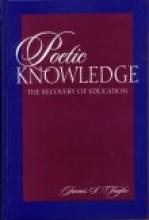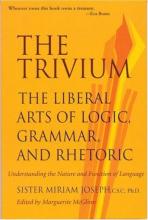(Additional Review, in response to the one above)
"There are relatively few persons who can analyze as clearly and as lucidly the writings of Aristotle, Plato, and Aquinas as does this author. Like Taylor's educational philosophy, he seeks to move his readers' affections and will as well as their intellects, and he does this successfully." - Richard Harp, University of Nebraska
When discussing "poetic knowledge" (which is not the knowledge of poetry "but rather a poetic experience of reality"), we are entering into the realm of an intuitive, obscure and somewhat mysterious way of knowing reality that therefor does not lend itself to strict analytical dissection. Nevertheless, in Poetic Knowledge Taylor has managed "with pithy brevity...to provide a history of the treatment of poetic knowledge and to develop his own very persuasive account" – Ralph McInerny (U. of Notre Dame). He cannot reasonably be faulted for failing to make human emotions and intuitions as readily understandable as an isosceles triangle or an elementary rule of grammar - there is more to it than is "dreamt of in our philosophy."
Ironically, it is precisely that relentless demand of modern man (since Descartes) - that all be broken down into parts and pieces for study under a magnifying glass - that Taylor is warning against in his book. A flower loses its beauty when it is hacked into tiny pieces for too close observation; "whatever the sun is, it is not just a mass of burning gasses", though strict analysis might yield just that answer.
Indeed, in writing this book for a modern audience drunk on statistics and mathematical calculation, Taylor assumed the risk of betraying the very thing he was trying to save - the rest of man: his sense, his intuitions, his love of beauty, his integrity and very ability to love. Happily, like a good diagnostic physician,Taylor managed to poke and probe only deeply enough to give us the outlines, to reveal the essentials of the matter without killing the patient in the process.
Like a multi-faceted diamond, poetic knowledge may be viewed from different perspectives, with differing results. Thus it can be considered as both a "degree" of knowledge and as a "mode" of knowledge. As a "mode" of knowledge, poetic knowledge differs from "scientific knowledge" in that is it non-analytical, nor is it about the "outside" of things as observational science is. Rather, it is sensory-emotional, intuitive and deals with the goodness or "inside" of things. It begins with the immediate, direct apprehension of reality that inspires wonder and awe. As a degree of knowledge, it is less certain that mathematical knowledge, but more certain than a mere guess or coin-flip. In short, it is of one certain degree or order, and not of another. A mere review such as this cannot do justice to those distinctions, but that should suffice to account for the fact that Taylor may reasonably approach the matter from different angles without being guilty of the charge of causing needless confusion. No diamond-cutter would do less before striking the blow, and Taylor is writing about more than a mere diamond, he is writing about why women love the beauty and "poetic" meaning of diamond gifts and why men love certain women enough to buy them diamonds.
Taylor makes the point that we live in a world dominated by scientism, by mathematical formulae, which knows the price of all things and the worth of nothing.
He rightly traces this domination back to Descartes, who was a superb mathematician. But Descartes, in promoting his liberal arts of preference - the quadrivium, neglected the rest - the trivium. In stating the obvious - that our world is terribly imbalanced towards the empirical sciences and away from its heart and soul (which is closer to the subject of the trivium) Taylor does us no disservice, nor does he thereby libel the sciences. He is merely trying to restore the balance before science and math bereft of love and beauty calculate us into greater mechanistic slavery or thermonuclear oblivion. One who rights a tottering man ought not be accused of favoring the right over the left, or up over down. Indeed, for left or down to have any meaning, right and up must be preserved as well. Science and math have no future if man has no future. Taylor seeks to restore our future as men and women, not merely as "consumer units" or "human resources".
The Renaissance is a vague term, with a vague start. But out if it did indeed spring modern empirical science as a reaction against the domination of the early Renaissance by rhetorical teachers of the trivium such as Petrarch. Descartes, building on Galileo (1564-1642), and his mathematical arts of the quadrivium, were the ultimate victors in the Renaissance Battle of the Arts, which therefor did triumph - not in the early Renaissance - but in the period of the late Renaissance and Reformation when the trivium and poetic knowledge began to be neglected precisely because of the rise of the quadrivium at that time.
Just as in the late Renaissance, the Battle of the Arts rages and the mathematical sciences still hold the upper hand. They hardly need any more defenders. But like the teacher Keating in the movie Dead Poets Society, Taylor calls us to arms against the tyranny of modern science:
"This is battle...War! And the casualties could be your hearts and your souls...One reads poetry because he is a member of the human race and the human race is filled with passion! Medicine, law, banking - these are necessary to sustain life - but poetry, romance, love, beauty! These are what we stay alive for!"
Restore the balance and the war ends. Then science and faith can indeed be understood harmoniously, but they certainly are not so understood by those in the thrall of modern scientism. In Poetic Knowledge Taylor shows us the way to restore the balance - in the recovery of authentic classical education.






